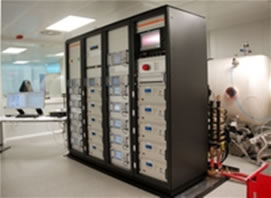A new experimental facility inaugurated in Valencia (Spain) will enable subjecting satellite components to up to 3,600 watts of power in radio frequency, leading to improvements in TV channels.
Telecommunication satellites have to manage and transmit an increasing number of higher-powered signals. The new experimental facility located in the European Space Agency’s (ESA) specialized laboratory in Valencia responds to these demands.
The facility is a multicarrier, and permits subjecting these communication satellite components to levels of up to 3,600 watts in radio frequency. “This will translate into more and better television channels, multimedia and voice which, further, will be able to reach areas of the planet where until today this was impossible”, explains David Raboso of the ESA, who is in charge of the laboratory.
The new Spanish facility has ten satellite signal generators, compared to the single signal that other European simulators have, with their corresponding power amplifiers. The signals are grouped by a combiner into a single output, in order to reach much higher levels of power.
In current satellites all these signals go through a single component: they must pass through the antenna to be sent to Earth. If the signals are in phase they produce a peak power that could endanger the mission if the components cannot withstand it. “We have found it necessary to generate more signals because that’s what occurs in real life”, state those responsible for the project.
The new Spanish project, carried out over two years, has been managed jointly by the ESA and the Valencia Space Consortium (VSC). It has included the participation of companies such as Valencia’s Aurora Software and Testing, a spin-off from the Universitat Politècnica de València, and the Universitat de València, and other companies such as Holland’s TNO and Apollo from Canada.
European Space Agency
